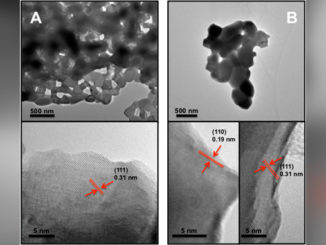
Tracking iron oxide nanoparticles in plant organs using magnetic measurements
Abstract: Common bean plants were grown in soil and irrigated with water solutions containing different concentrations of Fe3O4Fe3O4 nanoparticles (NPs) with a mean diameter close to 10 nm. No toxicity on plant growth has been detected as a consequence of Fe deficiency or excess in leaves. In order to track the Fe3O4Fe3O4 NPs, magnetization measurements were performed in soils and in three different dried organs of the plants: roots, stems, and leaves. Some magnetic features of both temperature and magnetic field dependence of magnetization M(T, H) arising from Fe3O4Fe3O4 NPs were identified in all the three organs of the plants. Based on the results of saturation magnetization MsMs at 300 K, the estimated number of Fe3O4Fe3O4 NPs was found to increase from 2 to 3 times in leaves of common bean plants irrigated with solutions containing magnetic material. The combined results indicated that M(T, H) measurements, conducted in a wide range of temperature and applied magnetic fields up to 70 kOe, constitute a useful tool through which the uptake, translocation, and accumulation of magnetic nanoparticles by plant organs may be monitored and tracked.
Author(s): Govea-Alcaide, E.; Masunaga, S. H.; De Souza, A.; et al.
Journal of Nanoparticle
Volume: 18 Issue: 10 Published: 2016
DOI: https://dx.doi.org/10.1007/s11051-016-3610-z
PDF: Tracking iron oxide nanoparticles in plant organs using magnetic measurements




